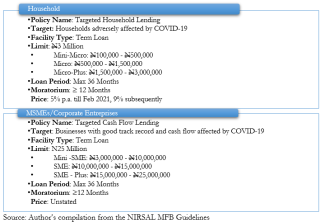
Posted by Chukwuemeka O. ONYIMADU[1]
The world economy is enduring a staggering downturn amidst the spread of COVID-19. Individuals and corporate organizations are already suffering from immediate losses of income, profits and employment status. The downturn has had a particularly harsh impact on workers in unstable and informal types of employment. The imposed economic slowdown has left many workers and entrepreneurs confined to their homes. In many developing countries, the nature of the labor market constrains the ability of these people to earn income.
Following the Nigerian government’s policy on the restriction of movement, inter-state travel bans, and quarantine measures, entrepreneurs and workers in Medium, Small, and Micro Enterprises (MSMEs) stand to lose a substantial proportion of their daily income, particularly informal and casually employed workers. To help mitigate these effects, the Central Bank of Nigeria (CBN) introduced a N50 billion (US$ 138 million) Targeted Credit Facility (TCF) as a stimulus package to support households and MSMEs affected by the pandemic. The CBN is using an intermediary institution – the NIRSAL Micro Finance Bank (MFB) - to implement this scheme. The facility provides termed loans with categorised maximum limits to households and MSMEs who can verify they have suffered adversely from the crisis, who must repay these loans over a period of 36 months (see below).
Click on the chart for a better image resolution
Source: Author’s compilation from the NIRSAL MFB Guidelines
The primary intent of the package is to mitigate the adverse effects of the pandemic on households and MSMEs. However, there is an obvious problem with the approach used for supporting households, namely through termed loans that are repayable with an interest rate of 5% per annum. Conventionally, it is not advisable to borrow for consumption, especially for low-income earners. Borrowing for consumption, rather than for productive activities, may make it impossible for borrowers to repay their debts.
The situation is worse for households who have lost their earnings during the crisis. As such, the associated interest rate of 5% (rising to 9% subsequently) is high and would likely lead to high default rates, as the loans are not 100% guaranteed by the CBN. Since the scheme is intended to augment household incomes, a better approach might be for the loans to be converted into grants, at least for mid–low income earners. This could be achieved by guaranteeing the beneficiaries a proportion of their monthly incomes (for example, a hypothetical 40% and 70% of monthly earnings for middle and low-income earners respectively). For higher income earners, termed loans with limits that are 100% secured by the CBN would suffice.
The package for MSMEs and corporate enterprises focuses on lost incomes, with the goal of stimulating productive activities, and ensuring that unemployment does not rise steeply. The model adopted for MSMEs and corporate enterprises is based on termed loans that are repayable at an undisclosed cost and are not secured by the CBN[2]. The combination of an unknown interest rate, no loan security by the CBN, and conditionalities that include the payment of collateral amounting to 70% of the loan amount, will discourage many MSMEs from applying for these loans. There is evidence to suggest that, requesting collateral and setting unfavourable high interest rates limits MSMEs’ access to credit[3].
In addition, the eligibility criteria for MSMEs are aligned with conventional bank borrowing practices without any recognition of the severity and urgent needs of the crisis. Only those MSMEs with a good record of accomplishment, acceptable cash flows, high sales proceeds, and an ability to meet the collateral conditions, will qualify as potential beneficiaries. For an MSME that cannot pay its total wage bill, it would be better if the termed loan could be guaranteed by the CBN or the loan repayments deferred until the economy has stabilized. MSMEs that intend to continue their productive activities but are constrained by high fixed factor costs such as ground rent or the maintenance of essential infrastructure, could be offered loan forgiveness equivalent to these fixed costs, as well as their loans being 100% guaranteed by the CBN.
In conclusion, we believe that the model developed by the CBN is flawed and will not be effective as currently structured. The scheme should be reviewed to ensure that its objectives are met.
This article is part of a series related to the Coronavirus Crisis. All of our articles covering the topic can be found on our PFM Blog Coronavirus Articles page.
[1] Research Fellow, National Institute for Legislative and Democratic Studies, National Assembly, Abuja, Nigeria.
[2] See https://nmfb.com.ng/wp-content/uploads/2020/03/LOAN-APPLICATION-GUIDELINE-SMEs.pdf
[3] See World Bank, Nigeria SME Finance 2011 – 2012 Survey Results & Conclusion.








